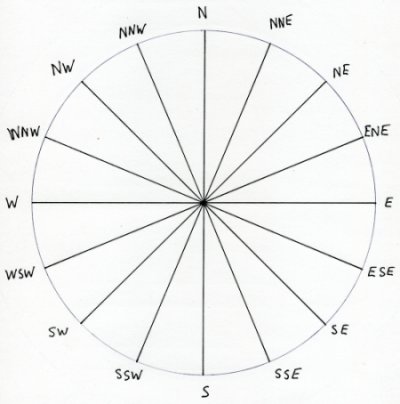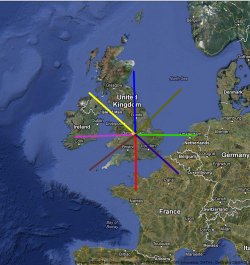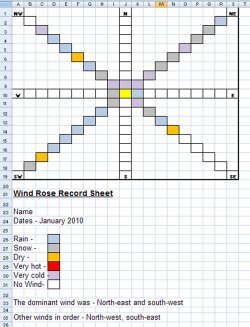Wind Direction and Wind Roses
It is important to know which direction the wind is coming from. Where the wind comes from influences the weather we get. If the wind comes from somewhere warm we may get warmer weather. If it comes across the sea we may get wetter weather. So depending on where the wind is coming from we get different combinations of warm or cold, and wet or dry weather. Where you are located will govern the types of weather that different directions bring. You can learn to use the wind direction to help in predicting the weather.
The information and activities below will help you to understand and develop some useful skills in you weather data recording. It is quite hard, but this will give you a little taste of weather forecasting, and perhaps show how complicated it is.
You will need to know where the wind is coming from. We use a weather vane to measure wind direction. See more about this on the Wind Measurements page. If you need to be reminded about the points of the compass look at the bottom of the More About Wind Measurements page. You can just use the eight points of the compass, or you can use the sixteen points of the compass for more accuracy.
When you have finished reading about this you may want to return to the Wind Measurements page, More About Wind page or Collecting Data. You may also like to have a go at the Wind Direction Quiz.
Wind and WeatherIn your location, what sort of weather will each wind direction bring? You need to find your location on a world map and then look in each direction. Find out if there is land or sea there. See if it is warmer of colder than where you are. |
|
Investigating Wind and WeatherIf you keep a record of the wind direction and the weather it brings, it may help you to work out what weather the different winds bring to your location. You could fill in the data on a spreadsheet to help work this out. |
|
Automatic Spreadsheet Wind RosesIt is possible to use a spreadsheet to graph your wind direction data. It can be set up to produce a graph that looks like a wind rose. Each wind direction is graphed as if it is on a compass. This helps you to imagine the wind coming from that direction. |
 |
Using a Paper-based Wind RoseIt is also possible to print out a wind rose and use it to record the wind directions. Each day you colour in a rectangle to show what direction the wind is coming from. Start from the middle where the letters for the wind directions are. If you can record the data for a whole month you will get a good idea of which wind direction has been the dominant one. If you want to work out what sort of weather each wind direction is more likely to bring there are extra instructions on this worksheet. Read the text that goes with the 'Investigating Wind and Weather' section above. This will help you to understand what you might discover. |
 |
Main Air MassesEach location round the world will have particular winds that bring specific weather from specific locations. These are know as Air Masses. Your work on monitoring the wind and the weather it brings might have helped you to discover some of these. You would need to repeat your activity during each of the four seasons. |
|
Tower of the WindsThe ancient Greeks knew that different winds bought different weather. See more about this on the Tower of the Winds page. The picture on the right is an ancient building called the Tower of the Winds. There are instructions on how to make your own Tower of the Winds for your location. You can do this once you decide what weather each wind brings to your location. |
 |
Points of the CompassAs stated on the Wind Measurements Page, the eight points of the compass can be used to record where the wind is coming from. If you want to be more accurate, sixteen points of the compass can be used. See the sixteen points of the compass in this larger format. |
 |





